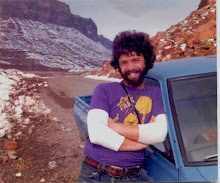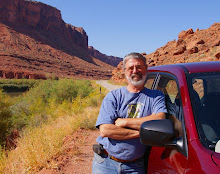 The canyon became my secret little place, a rugged defile that started out as a shallow sandy wash but quickly etched itself into the Permian sandstones and limestones of the Colorado Plateau. I discovered it on a cold December day while walking along an unremarkable arroyo that wound, like so many others, through sage and saltbush and cow-beaten grasses along the edges of Squaw Flat. But within a half mile or so, I could see that this one was somehow different from the rest. The shrubby landscape quickly gave way to cottonwood-lined banks as the wash became a creek and the creek became a gorge. And along those banks were occasional masses of ice, attached like burls to the sides of the streambed and bedecked with rippled icicles. These were clearly frozen springs.
The canyon became my secret little place, a rugged defile that started out as a shallow sandy wash but quickly etched itself into the Permian sandstones and limestones of the Colorado Plateau. I discovered it on a cold December day while walking along an unremarkable arroyo that wound, like so many others, through sage and saltbush and cow-beaten grasses along the edges of Squaw Flat. But within a half mile or so, I could see that this one was somehow different from the rest. The shrubby landscape quickly gave way to cottonwood-lined banks as the wash became a creek and the creek became a gorge. And along those banks were occasional masses of ice, attached like burls to the sides of the streambed and bedecked with rippled icicles. These were clearly frozen springs.Beaten back by the frigid shadows, I made up my mind to return in a few months to see if my initial observations were correct. And I was not disappointed when, in early May, I once again headed down into the canyon. The cottonwood trees were now leafing out into galleries of green. And the frozen globs of ice were now free flowing springs, alive with bright water. In about a mile I reached a point where the cottonwood canopy closed in and fresh water came bubbling out of the creek bottom, creating a small but lively stream. I drank from the spot where the water emerged from the earth….and it was the best water I had ever tasted.
On future trips I would continue to explore further and further down the canyon finding small waterfalls, deep pools lined with wild orchids, and large arching alcoves full of pale canyon columbines. I began taking my friends there whenever I got the chance. And if I were with a woman, the wildness and seclusion of the place created a primal playground where we could take off our clothes, make love, bathe in the cold pools, or simply catch a nap on a shaded ledge. It was my Eden on earth.
As the canyon cut itself into the planet’s skin, it became more and more rugged. The creek bed narrowed and was often overgrown with reeds. Steep talus slopes descended on both sides, full of angular boulders and scree. There were places in the blue-gray limestone where one could find hundreds of fossil brachiopods and crinoid stems. On one occasion, near the source of the biggest springs, I found several arrow heads and part of a yucca woven sandal under a small boulder, being careful to put them back where I found them.
One summer day I spent an entire afternoon by a single, shallow pool reading Robert Graves’ I Claudius. Another time I decided to rescue as many stranded tadpools as I could, carefully removing them from cutoff pools with my Sierra cup, and releasing them downstream. Cindy and I waited out a rainstorm one April afternoon in a protected alcove . Then there was the epic trip where Phil and I took mescaline and hiked far down into the cut earth, nearly to the Colorado River, only stopping because of a formidable drop off.
In those few short years when I was intimate with the place, the canyon came to represent all that was awesome, provocative, exciting and enabling. The power of raw nature. The miracle of water in the desert. The gift of silence and serenity. And while I may never get back to my special place any time soon, I know that it is still there. And I am grateful for having spent some of the most supreme and enlightening moments in those rocky recesses where the water always flows and the ravens soar through a timeless space.







